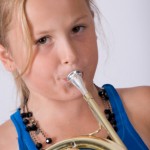Young Players and Band Directors
 I am glad that you have found this website. One of the greatest challenges I face as a teacher is taking players through an embouchure change and I have done it often. It is critical for a successful career to have a functional and efficient embouchure. When is the best time to have this set up? Day 1!
I am glad that you have found this website. One of the greatest challenges I face as a teacher is taking players through an embouchure change and I have done it often. It is critical for a successful career to have a functional and efficient embouchure. When is the best time to have this set up? Day 1!
The best time for an embouchure change is the first moment the mouthpiece is placed on the lips. If you are a beginner or a band director, please start off your brass players with 2/3 upper lip and 1/3 lower lip in the mouthpiece. And, be diligent about watching to make sure the players keep their chin muscles flexed and not crunched up. These are just two of the “5 Must Have Techniques” from Video 1 which I expand on in later videos.
Many young trumpet players change to horn either by the wishes of their band director or from some other noble calling. It is critical that the horn embouchure be used is 2/3 upper 1/3 lower lip and not 1/2-1/2 or worse, 1/3 upper 2/3 lower. I have noticed some of the greatest orchestral and jazz trumpet and trombone players of our time use the ‘universal’ brass embouchure (2/3 upper 1/3 lower lip) that I describe in my videos. Of course there are exceptions and you can hear the difference in their sound too.
Give yourself or your students the best chance for a rich tone and a choice to play professionally later on. Start them now with 2/3 upper 1/3 lower lip in the mouthpiece and play with a chin that is flexed and firm and not crunched up!
Here is an easy step by step check list to help set up your student’s embouchure (or your own).
1) Flex and firm bottom lip slightly under the top lip like you are buzzing a high note. Chin muscle is firm and flexed, pulling the bottom lip downwards.
2) Place the bottom rim of the mouthpiece (MP) just below the bottom lip pink line.
3) Press MP on both lips ensuring that lots of fat, relaxed top lip is inside the rim (not stretched) at the ratio of 2/3 upper lip, 1/3 lower lip.
4) Blow air into the MP with the mouthpiece angled down slightly to ensure that the top lip is free to buzz.
5) Allow a buzz to happen on any note as long as the chin is firmly flexed and there is 2/3 upper, 1/3 lower lip in the MP. See the videos for visual help.




